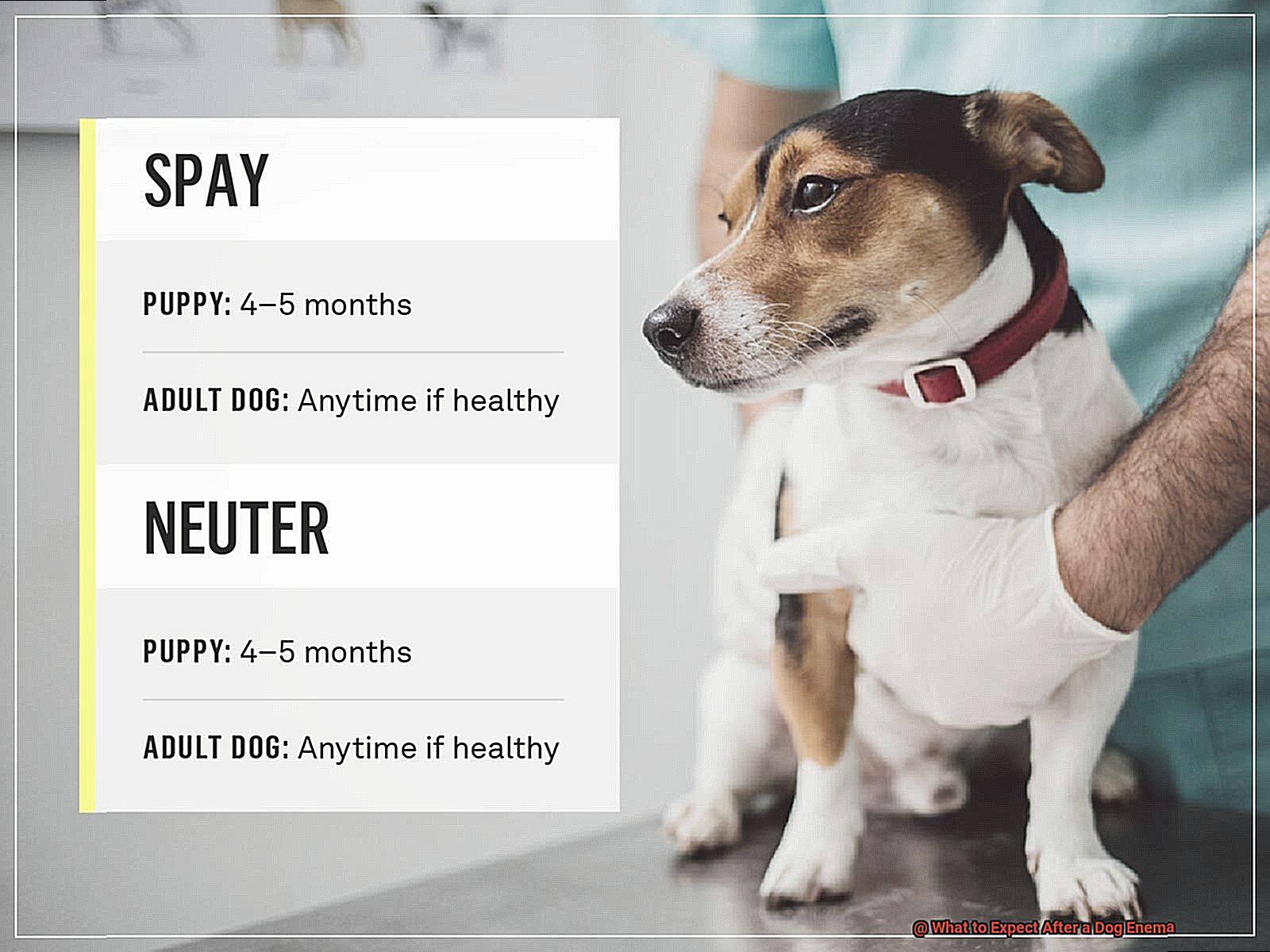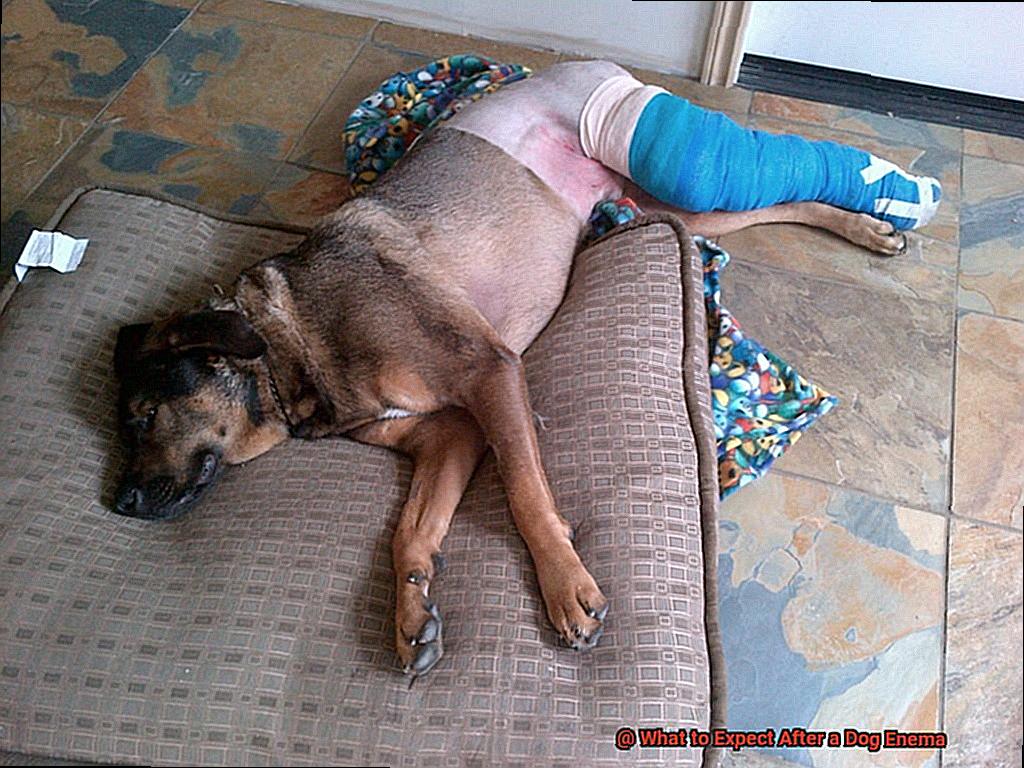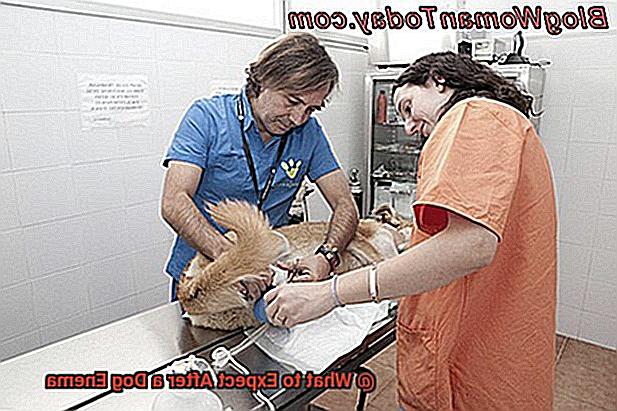What to Expect After a Dog Enema?
It’s not a pleasant experience to give your dog an enema, but the recovery process is just as important. Knowing what to expect can help ensure your pet’s safety and wellbeing.
Enemas are used to flush out the lower intestines of any disease-causing diarrhea or vomiting in dogs. After the procedure, you should watch for signs of pain or discomfort. If your pet is sick or in pain, seek medical attention right away. Also look out for dehydration: excessive panting, dry nose, sunken eyes, lethargy and reduced appetite.

Diarrhea or vomiting after the enema may mean it was not effective so further medical attention may be necessary. If your dog has been prescribed drugs, make sure they take it as directed and contact your vet if there are any questions about dosage or side effects.
By understanding what to expect after a dog enema you can ensure that your pet recovers quickly and comfortably from this critical procedure.
Understanding the Benefits of a Dog Enema
Contents
- 1 Understanding the Benefits of a Dog Enema
- 2 How to Determine if An Enema Is Right for Your Dog
- 3 Consulting With Your Veterinarian
- 4 Types of Enemas
- 5 How Often Should I Administer An Enema?
- 6 Risks When An Enema Is Ineffective
- 7 When Would You Consider An Enema?
- 8 What to Expect After a Dog Enema?
- 9 What are the after effects of an enema?
- 10 How long does it take for pet enema to work?
- 11 How long after the enema does poop come out?
- 12 What does an enema do to a dog?
- 13 Conclusion
Are you considering a dog enema to help your pup’s digestive health? A dog enema is a medical procedure that involves inserting a liquid solution into the rectum of the dog. This can provide relief from constipation and other digestive issues, reduce inflammation in the intestines, and flush out toxins from the body.
Before trying an enema at home, it’s important to speak with your veterinarian first. Enemas should only be administered under medical supervision because they can have potential side effects if done incorrectly. Your veterinarian may also prescribe an enema as part of a treatment plan for certain illnesses or conditions.
The benefits of a dog enema are numerous. It helps flush out the intestines while also reducing constipation and other digestive disorders. It can also help alleviate inflammation in the intestines and flush out toxins from the body. In addition, an enema may be recommended by a veterinarian as part of a treatment plan for certain illnesses or conditions.
If you believe this procedure will benefit your dog, make sure to consult with a licensed specialist first.
How to Determine if An Enema Is Right for Your Dog
Enemas are a medical procedure that can be beneficial for a variety of reasons, including relieving constipation, treating diarrhea, and providing relief from intestinal parasites.
But before administering an enema to your pet, it is important to consult with a veterinarian to determine if it is necessary and safe. Here, we will discuss how to determine if an enema is a right option for your dog.
Consulting With Your Veterinarian
Before deciding to use an enema for your dog, it is essential to consult with your vet to ensure that it is the right treatment for their particular situation. Your vet will evaluate the health of your dog and decide if an enema is the best option.
If your dog has a serious medical condition, such as an obstruction in their intestines, an enema may not be suitable and could cause further harm.
Types of Enemas
Depending on the individual situation, your vet will advise you on the type of enema that is right for your dog. There are lubricant-based enemas that help soften stool and promote bowel movement; saline-based solutions that help flush out toxins; and mineral oil-based solutions that help lubricate the intestinal walls and reduce inflammation.
How Often Should I Administer An Enema?
The frequency of administering an enema varies depending on the type of treatment you use and the disease you are trying to treat in your dog. Based on these factors, as well as other pertinent information regarding your dog’s health, your vet will advise you on how often you should administer the enema.
Most dogs require between one and three treatments per month, depending on their individual needs.
Risks When An Enema Is Ineffective
It’s important to note that administering an enema can result in dehydration, electrolyte imbalance, irritation of the rectal mucosa or even more severe problems such as perforation of the bowel if administered incorrectly or without adequate supervision by a licensed specialist.
Therefore, you must follow all directions provided by your vet when administering any type of enema to ensure that it is safe and effective for your pet’s well-being.
When Would You Consider An Enema?
An enema should only be used as a last resort after all other treatments have failed. Your veterinarian can guide when it might be appropriate for use in certain cases where other treatments have not been successful or are not available or feasible due to cost or availability concerns.
What to Expect After a Dog Enema?
Enemas can be an effective way to treat constipation in dogs, but it’s important to understand what to expect after the procedure. To ensure your pup’s well-being and comfort, it’s important to keep track of their behavior and health following an enema. Here’s what you should anticipate after a dog enema.
Constipation Relief
The primary goal of administering a dog enema is usually to alleviate constipation. After the enema, you can expect your pup to experience some relief from their constipation as the gel helps flush out any impacted feces in the colon.
Comfort and Relaxation
After the procedure, your pup will likely be more comfortable and relaxed due to the lubricating properties of the fluid used in the enema which help reduce irritation or inflammation in the colon.
Enhanced Energy Levels
Depending on the type of enema used, you may also observe an increase in energy levels as well as improved overall health in your pup. This is because constipation can be both physically draining and painful for dogs, so relieving this discomfort can help them feel more alert and energetic.
Fluids and Food
To ensure your pup stays hydrated and nourished, it’s essential to provide plenty of fluids and food after an enema. This will also help them recover quickly from any cramping or pain caused by the procedure.
Signs of distress or discomfort
Additionally, it’s important to watch for signs of pain or distress after the procedure as these may indicate that something is wrong with the enema or that other underlying issues are present. If your dog displays any of these symptoms for more than 24 hours following an enema, you should contact your veterinarian right away for further advice.
What are the after effects of an enema?
An enema is a surgical procedure that involves inserting a liquid into the rectum to help clear the bowels. Both humans and animals, such as dogs, can be used. If your pup has had an enema, it’s important to know what the after-effects may be.
Your dog may experience abdominal cramping, nausea, vomiting, increased gas production and diarrhea. It’s essential to keep an eye on your pup for any signs of infection or dehydration following the enema. If any of these symptoms persist for more than 24 hours, it is best to contact your veterinarian for further advice.
Water is key when it comes to avoiding dehydration in your pup.
How long does it take for pet enema to work?
Enemas can be a quick and effective way to help your dog feel better if they are suffering from digestive issues. On average, the liquid in an enema takes around 10 minutes to be absorbed into the rectum and colon of a canine.
However, this time may vary depending on the breed and size of your pet, as well as the type and amount of fluid used. Generally speaking, larger dogs may take longer for an enema to take effect than smaller dogs.

It is important to keep a close eye on your pet during this time in case they experience any discomfort or adverse reactions. If you suspect that your dog is not feeling well after the enema, please contact your veterinarian right away.
Enemas can be a helpful device when used correctly, but you should always consult with your doctor before starting one to ensure you’re using the right method and dosage.
How long after the enema does poop come out?
The answer varies depending on the size of your pup, the type of enema used, and other factors.
Generally speaking, most dogs will have their first poop within 1-2 hours of an enema being administered. But some pups may take as long as 12 hours or more before they have their first bowel movement.
If your dog doesn’t poop within 12 hours after an enema, it’s best to contact your veterinarian for further advice. They’ll be able to help you figure out what’s going on and how to make your pup feel better.
Enemas can be a great way to relieve constipation in dogs and get them back to regular pooping.
What does an enema do to a dog?
An enema could be the answer.
This safe and effective method helps relieve constipation and other digestive disorders in dogs. How does it work? By introducing a liquid solution into the rectum, it softens and loosens the stool, making it easier to pass. Plus, an enema can reduce inflammation in the intestines, reduce gas and bloating, and flush out toxins that might be causing distress.
Conclusion
Enemas can be an effective way to treat digestive issues in dogs, but it’s important to know what to expect afterward. After the procedure, your pup may feel more relaxed and comfortable due to the lubricating properties of the fluid.
Additionally, they may experience an increase in energy as constipation can be both physically draining and painful. To ensure a speedy recovery, make sure your dog is well-hydrated and nourished following the enema.
Lastly, keep an eye out for signs of pain or distress – this could indicate something is wrong with the procedure or another underlying cause.
Enemas should only ever be done under medical supervision.




